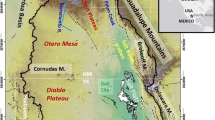Abstract
At least three major evaporite dissolution events have developed deep karst in two zones of the northern Michigan basin. Dissolution of outer margin Silurian evaporites resulted in the Mackinac Breccia during the early Devonian. This rebound and exposure or a later, brief basin rebound also caused the development of surficial evaporate epikarst in the middle Detroit River Group before the next subsidence and new deposition. Pleistocene glaciation pumped fresh water into shallow Silurian and Devonian carbonate aquifers and stressed the formations by repeated loading and unloading. Buried early Devonian paleokarst in the Detroit River Group was affected by hydrostatic pressure from the glacial waters and exposure along hydraulically open faults and fractures which developed the ancient karst. The current karsted zone varies from totally removed evaporites and collapsed formations along the northern margin of the Detroit River Group subcrop, to an irregular active evaporite dissolution front 29–39 km further basinward. The last glacial retreat from the Lake Huron basin approximately 10,000 years before present (ybp), opened and flooded the basin, The level dropped approximately 150 m in the Lake Huron basin to Lake Stanley stage at 10,000–7,500 ybp to approximately 58 m compared to the present 177 m above sea level of Lake Huron. This is likely the time when most of the visible collapse sinkholes in Northern Michigan formed. Some of these sinkholes have been identified in Lake Huron recently by subbottom profiling. Water venting from them into the lake has conductivity values ranging from 123 to 1,821 μS/cm, attributed to high levels of chloride and sulfate. A benthic ecosystem of anoxic chemosynthetic bacteria is established in mat and bacteria filament forms at the vents. There are no land springs from this system which has hundreds of square kilometers of active swallow area.



Similar content being viewed by others
References
Biddanda BA, Nold SC, Ruberg SA, Kendall ST, Sanders TG, Gray JJ (2009) Great Lakes sinkholes—a microbiogeochemical frontier. Eos Am Geophys Union Trans 90(8):61–68
Black T (2003) Evaporite karst in Michigan. In: Sinkholes and the engineering and environmental impacts of karst, ASCE Geotechnical Special Publication 122 Proceedings of the Ninth Multidisciplinary Conference, Huntsville, Alabama, 2003, pp 141–149
Coleman DF (2002) Underwater archaeology in Thunder Bay National Marine Sanctuary, Lake Huron–preliminary results from a shipwreck mapping survey. Marine Technol Soc J 36(3):33–44
Farrand WR (1988) Glacial Lakes around Michigan: Geological Survey Division, Michigan Department of Environmental Quality, Bulletin 4, p 23
Gardner WC (1974) Middle Devonian stratigraphy and depositional environments in the Michigan Basin: Michigan Basin Geological Society, Special Paper No. 1, p 39
Lewis CFM et al (2008) Dry climate disconnected the Laurentian Great Lakes. Eos Am Geophys Union Trans 89(52):541–552
McIntosh JC, Walter LM (2006) Paleowaters in Silurian-Devonian carbonate aquifers—geochemical evolution of groundwater in the Great Lakes region since the Late Pleistocene. Geochim Cosmochim Acta 70(10):2454–2479
Ruberg SA, Coleman DF, Johengen TH, Meadows GA, Van Sumeren HW, Lang GA, Biddanda BA (2005) Groundwater plume mapping in a submerged sinkhole in Lake Huron. Marine Technol Soc J 39(2):65–69




